Rudnick L. Lubricant Additives: Chemistry and Applications (Присадки, добавки к смазкам)
Подождите немного. Документ загружается.

524 Lubricant Additives: Chemistry and Applications
This chapter focuses on lubricants for the magnetic recording disk and the spindle bearing
motor. Emphasis is placed on the analytical tools that are common to lubricants in general. Similar
techniques are applied to characterize the physical properties of lubricants that in uence their
performance. Rheological measurements are employed not only to characterize the viscosity, but
also to estimate the short-time dynamic response of disk lubricants through time–temperature
superposition. Shear rheometry is exploited to characterize the yield stress of grease, as well as the
effect of blending on uid dynamic bearing motor oils. Dielectric spectroscopy is utilized to probe
the dipole relaxation of disk lubricant end groups. Dielectric permittivity and conductivity measure-
ments are employed for development of conductivity additives for ferro uid used in motor seals and
to investigate the effects of contamination on ball bearing grease electrochemistry. Another power-
ful technique that is highlighted in this chapter is Fourier transform infrared (FTIR) spectroscopy.
This method can be used to study thin lms in re ection or bulk samples in transmission. Examples
are shown in which infrared (IR) spectroscopy is also applied to identify reaction products formed
during electrochemical oxidation of ball bearing grease. Thermal analysis is employed to measure
the vapor pressure of disk lubricants. A model is described that simulates evaporation of polydis-
persed lubricants from molecular weight distributions measured with gel permeation chromatog-
raphy (GPC). Surface energy from contact angle measurements is combined with the chemical
kinetic model for viscous ow and evaporation to predict the viscosity of molecularly thin lms
and to understand factors that limit lubricant spin-off from rotating disks. The chemical kinetic
model is also employed to combine vapor pressure and viscosity data in the quest for the molecular
structure of a uid bearing motor oil that has both low viscosity and vapor pressure. Not only are the
techniques illustrated here with examples from the disk drive industry applicable to the lubrication
industry in general, but they will also be particularly useful in adapting these methodologies to the
tribology of micro- and nanoelectromechanical systems.
In this revised chapter, nuclear magnetic resonance (NMR) spectra of several uid dynamic
bearing oils are included to highlight the chemical structural differences. As accelerated motor life
tests, and even tests on stabilized oils at elevated temperatures take a very long time, a kinetic model
that includes the synergistic effects of primary antioxidant (PriAOX) and secondary antioxidant
(SecAOX) and metal catalyst on oil oxidation lifetime is presented to help estimate the optimum
additive concentrations. Examples of accelerated oil life testing are shown with an aromatic amine
PriAOX and an alkyl dithiocarbamate SecAOX as well as the effect of dissolved metal catalyst in
isothermal accelerated oil oxidation life tests.
22.2 RECORDING DISK LUBRICANTS
The soft magnetic layers on the magnetic recording disk substrate are typically overcoated with a
3–5 nm thick carbonaceous lm. As the overcoat has a relatively high surface energy, a low- surface
energy per uoropolyether (PFPE) lubricant is applied on top of the overcoat. The most widely used
PFPEs are those having the Z-type backbone chain. These are random copolymers with the linear
backbone chain structure:
X–[(O CF
2
)
m
–(O CF
2
CF
2
)
n
–(O CF
2
CF
2
CF
2
)
p
–( O CF
2
CF
2
CF
2
CF
2
)
q
]
x
0
–O X
where X is the end group and Z the backbone chain with degree of polymerization x
0
.
A wide range of end groups is available to tailor the lubricant for optimum lubrication proper-
ties. The end groups for some of the commercially available lubricants are given in Table 22.1 [1].
The adsorption energy of end groups (other than –CF
3
) on the carbon overcoat surface is higher
than that of the backbone chain [2,3]. The X1P type end group on A20H [4,5] is sterically large in
comparison to the chain monomers [6], and the X1P end group molecular weight of ∼1000 Da is a
signi cant contribution to the molecular weight of commonly used backbone chains of 2000–4000
Da [7]. Lower-molecular-weight end groups, also intended to passivate Lewis acid sites, are derived
from Zdol with dipropylamine [8] and referred to as ZDPA.
CRC_59645_Ch022.indd 524CRC_59645_Ch022.indd 524 3/20/2009 5:44:19 PM3/20/2009 5:44:19 PM
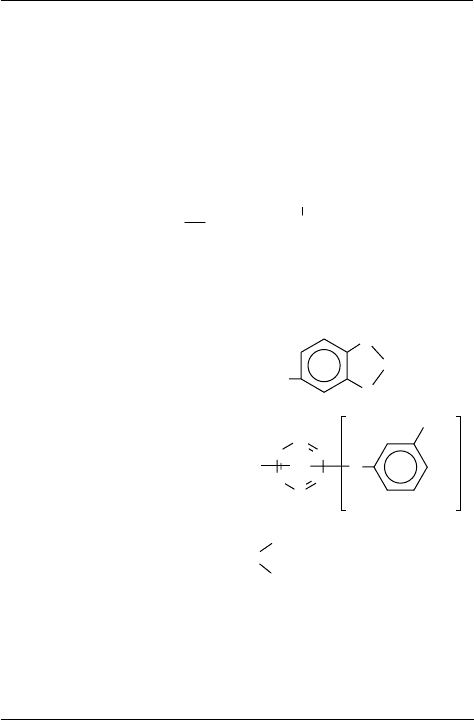
Lubricants for the Disk Drive Industry 525
The molecular structures of the D and K series of PFPEs, also considered for magnetic recording
disk lubricants at one time, are given in Table 22.2 [1]. The repeat unit of the D chain is per uoro
n-propylene oxide. The D series includes Demnum with nonpolar end groups, Demnum SA with
a hydroxyl end group, and Demnum SH with a carboxylic acid end group. The repeat unit of the
K chain is per uoro isopropylene oxide. The K series includes Krytox with nonpolar end groups
and Krytox COOH with a carboxylic acid end group.
Recently, PFPE magnetic recording disk lubricants have been developed with a multiplicity of
hydroxyl end groups to increase their chemisorption to the overcoat (Table 22.3) [1]. Two Zdol chains are
linked with epichlorhydrin to form a Zdol multidentate (ZDMD) with one hydroxyl group at each end
and one in the middle [9]. Two Ztetraol chains are linked with a uorinated di-epoxide to form a Ztetraol
multidentate (ZTMD) with two hydroxyl groups at each end and four near the middle [10]. A novel three-
arm star multidentate PFPE comprising poly per uoroethylene oxide was derived by direct uorination
of the hydrocarbon ester with one hydroxyl group at the end of each arm (LTA-30) [11,12] (Table 22.3).
22.2.1 PROPERTIES
PFPEs are attractive as magnetic recording disk lubricants because of their low surface energy,
low vapor pressure, wide liquid range, transparency, and lack of odor. PFPEs are related to
polytetra uoroethylene, but they have lower glass transition temperatures [13–15]. The rst
commercially available PFPEs had per uoromethyl end groups and are referred to as nonpolar PFPEs.
More recently, polar PFPEs with hydroxyl, carboxylic acid, and other polar end groups have come
TABLE 22.1
Molecular Structure for Some of PFPE End Groups on
the Z-Type PFPE Chain
Name Structure
Z – CF
3
Zdol – CF
2
CH
2
OH
Ztetraol
CF
2
CH
2
OCH
2
CHCH
2
O
H
OH
Zdiac – CF
2
COOH
Zdeal – CF
2
COOCH
3
Zdol TX –CF
2
CH
2
(OCH
2
CH
2
)
1.5
OH
AM-3001
CH
2
O
CF
2
CH
2
OCH
2
O
−
A20H
CF
2
CH
2
O
N
P
N
P
N
P
O
CF
3
5
−
ZDPA
CF
2
CH
2
N
CH
2
CH
2
CH
3
CH
2
CH
2
CH
3
−
Note: A20H has one Zdol end group.
Source: Adapted from Rudnick, L.R. (ed.), Synthetics, Mineral Oils, and
Bio-Based Lubricants Chemistry and Technology, Chapter 38,
CRC Press, Taylor & Francis Group, Boca Raton, FL, 2006.
CRC_59645_Ch022.indd 525CRC_59645_Ch022.indd 525 3/20/2009 5:44:19 PM3/20/2009 5:44:19 PM

526 Lubricant Additives: Chemistry and Applications
into widespread use. The polar end group provides an additional means to adjust the uid properties
and the interaction with surfaces. PFPEs with polar end groups are predominantly used to lubricate
present day rigid magnetic recording media.
Their versatility has motivated considerable and detailed study of PFPEs. The bulk viscosity and
glass transition temperature of the nonpolar PFPEs have been extensively characterized by Sianesi
TABLE 22.2
Molecular Structure of D- and K-Type PFPEs
Name Structure
Demnum S100
CF
2
CF
3
x
o
CF
3
CF
2
CF
2
O−
CF
2
CF
2
CF
2
O
−
Demnum SA
CF
3
CF
2
CF
2
OCF
2
CF
2
CH
2
x
o
−−−
CF
2
CF
2
CF
2
O
OH
Demnum DPA
CF
3
CF
2
CF
2
OCF
2
CF
2
CF
2
O
CH
2
CH
2
CH
3
CH
2
CH
2
CH
3
CF
2
CF
2
CH
2
N
x
0
−−
−
−
Demnum SH
CF
3
CF
2
CF
2
O
O
x
o
−
−
CF
2
CF
2
C
−
O
H
CF
2
CF
2
CF
2
O
Krytox 143AD
CF
3
CF
2
CF
2
O
CF
3
CF
2
O
x
o
−−
−
−
CF
2
CF
3
CF
Krytox COOH
CF
3
CF
2
CF
2
O
CF
3
CF
2
O
CF
3
C
O
OH
x
o
−
−
−
−
−−−
CF
CF
Source: Adapted from Rudnick, L.R. (ed.), Synthetics, Mineral Oils, and Bio-Based Lubricants Chemistry
and Technology, Chapter 38, CRC Press, Taylor & Francis Group, Boca Raton, FL, 2006.
TABLE 22.3
Multidentate Disk Lubricant Structures Derived from Z-Type PFPEs
Name Structure
ZDMD
HOCH
2
CF
2
Z OCF
2
CH
2
OCH
2
CHCH
2
OCH
2
CF
2
Z OCF
2
CH
2
O
H
OH
−
−
−−
−
ZTMD
OCF
2
CH
2
OCH
2
CHCH
2
OCH
2
CHCF
2
CF
2
CF
2
CHCH
2
OCH
2
CHCH
2
OCH
2
CF
2
OH OH OH OH
Z
OH
HOCH
2
CHCH
2
OCH
2
CF
2
Z OCF
2
CH
2
OCH
2
CHCH
2
OH
OH
LTA-30
OCF
CF
2
O
CF
2
O
CF
2
CF
2
O
OCF
2
CF
2
CF
2
OH
CF
2
CF
2
O
HOCF
2
x
x
x
−
−−
−
−
−
−−
CF
2
OH
Note: The ZDMD is derived from Zdol 1000 or Zdol 2000. The ZTMD is derived from Ztetraol 1000. The LTA-30 has a
molecular weight of 3000 Da.
Source: Adapted from Rudnick, L.R. (ed.), Synthetics, Mineral Oils, and Bio-Based Lubricants Chemistry and Technology,
Chapter 38, CRC Press, Taylor & Francis Group, Boca Raton, FL, 2006.
CRC_59645_Ch022.indd 526CRC_59645_Ch022.indd 526 3/20/2009 5:44:20 PM3/20/2009 5:44:20 PM

Lubricants for the Disk Drive Industry 527
et al. [13], Ouano et al. [16], Cantow et al. [17], Marchionni et al. [18–21], Cotts [22], and Ajroldi
et al. [23]. Subsequent investigations have begun reporting the properties of PFPEs with polar end
groups, for example, Danusso et al. [24], Tieghi et al. [25], Ajroldi et al. [26], and Kono et al. [27].
The composition and molecular weight of several PFPE lubricants, measured by NMR
spectroscopy [28], is given in Table 22.4 [1].
22.2.1.1 Viscoelastic (Rheological)
Oscillatory shear and creep measurements were done with a Carri-Med CSL 500 (now TA
Instruments) Stress Rheometer with the extended temperature module and a 40 mm diameter
parallel plate xture. The dynamic strain amplitude was 5%, and this was within the range of linear
viscoelasticity for these materials. The storage, G′, and loss modulus, G″, were measured between 1
and 100 rad/s at each temperature. Typically, measurements were done at every 20°C, from −20 to
−100°C. Low-temperature measurements were performed to provide the high-frequency properties
needed for calculations at the short time scales encountered in asperity contacts. The data measured
at low temperature are transformed to high frequency through time–temperature superposition with
Williams-Landel-Ferry (WLF) coef cients [29] that are derived from the rheological measurement
data. The PFPEs were linearly viscoelastic at these test conditions. The dynamic properties were
independent of strain amplitude, and no harmonic distortion of the sinusoidal angular displace-
ment waveform was observed even at the lowest measurement temperatures. Time–temperature
superposition was employed to obtain the master curves [30]. Viscosities for the lubricants at each
temperature were calculated from the steady-state creep compliance. The glass transition tempera-
tures, T
g
, were measured using a modulated differential scanning calorimeter manufactured by TA
Instruments model number 2920 MDSC V2.5F. The samples were cooled to −150°C and heated to
TABLE 22.4
The Composition of Several PFPEs
Lubricant mn p qm/nO/CxM
n
(Da)
Z03 0.530 0.405 0.057 0.008 1.31 0.754 73.4 6810
Zdiac 0.508 0.435 0.048 0.008 1.17 0.744 24.4 2310
Zdeal 0.567 0.426 0.003 0.004 1.33 0.782 22.8 2070
Ztetraol 2000 0.485 0.515 0 0 0.94 0.743 23.2 2300
Ztetraol 1000 0.523 0.477 0 0 1.10 0.762 14.2 1270
Ztx 0.475 0.517 0.007 0.001 0.92 0.736 22.7 2230
Zdol4KL819 0.612 0.383 0.003 0.0025 1.60 0.720 46.5 4000
Zdol4KL492 0.568 0.425 0.005 0.002 1.34 0.693 39.1 3600
Zdol4KL990 0.515 0.475 0.005 0.005 1.08 0.666 39.2 3600
Zdol4KBL598 0.492 0.508 0 0 0.97 0.658 47.2 4300
Zdol4KL905 0.469 0.526 0.0025 0.0025 0.89 0.650 41.5 3900
Zdol 2500 0.456 0.544 0 0 0.84 0.728 26.1 2420
Demnum S100 — — — — — 0.333 31.7 5230
Demnum SA2000 — — — — — 0.333 12.6 2080
Demnum SA2 — — — — — 0.333 18.6 3080
Demnum DPA — — — — — 0.333 48.4 8100
Demnum SH — — — — — 0.333 18.3 3040
Krytox 143 AD — — — — — 0.333 39.8 6580
Krytox COOH — — — — — 0.333 32.3 5370
Note: The degree of polymerization x = x
o
+ 2. The Zdol4K series are different batches of Zdol 4000 from the
manufacturer.
Source: Adapted from Rudnick, L.R. (ed.), Synthetics, Mineral Oils, and Bio-Based Lubricants Chemistry and
Technology, Chapter 38, CRC Press, Taylor & Francis Group, Boca Raton, FL, 2006.
CRC_59645_Ch022.indd 527CRC_59645_Ch022.indd 527 3/20/2009 5:44:22 PM3/20/2009 5:44:22 PM

528 Lubricant Additives: Chemistry and Applications
20°C at 4°C/min with a 1.5º modulation over a period of 80 s. The differential heat ow and tem-
perature phase shift were measured to determine the reversible and nonreversible components of the
heat ow. The glass transition temperatures of several PFPE lubricants are listed in Table 22.5 [1].
The temperature dependence of the viscosity is shown in Figures 22.1 through 22.3 [1] as the
ratio of the viscosity to the molecular weight η/M
n
plotted as a function of distance from the glass
transition temperature T – T
g
. The ratio η/M
n
is proportional to the segmental friction coef cient [30],
and shifting the temperature by T
g
takes into account the effect of T
g
on the relaxation times. The
smooth curves are from the regression t of the shift factors in the WLF equation. A subset of the
Z series showing the effects of different end groups is shown in Figure 22.1. Most of the PFPEs
shown in Figure 22.1 had an O/C ratio of ∼0.65, except for the Zdeal, which had an O/C ratio of
0.694. The segmental friction coef cient was the lowest for nonpolar Z03 and the Zdol4KL905
(and Zdol4KL819 shown in Figure 22.2), and highest for the Ztetraol, with two hydroxyls on each
end group. The segmental friction coef cients for Z chains with other types of end groups were
in between Z03 and Ztetraol. The friction coef cient for the Zdeal was slightly lower than the
Zdiac, because the methyl ester probably blocks some of the hydrogen bonding. The Ztx, Zdiac, and
Zdol2500 had nearly the same segmental friction coef cient.
The effect of the O/C ratio on the segmental friction coef cient for the Zdol 4K series is shown
in Figure 22.2. The lots with intermediate O/C ratio, Zdol4K L492, 990, and 598, were above
Zdol4K L819 with (high) O/C = 0.72 and Zdol4KL905 with (low) O/C = 0.65, which were about
the same as one another, even though their T
g
are 11° apart. This surprising relationship may arise
from a dependence of the segmental friction coef cient on the chain exibility and the cohesive
energy density that is different from the dependence of T
g
on these properties.
TABLE 22.5
The Glass Transition Temperature and the WLF Coeffi cients
of Several PFPEs
Lubricant T
g
(°C) C
1
C
2
Z03 −131.8 14.13 24.51
Zdiac −118.4 18.14 25.90
Zdeal −120.2 17.25 23.64
Ztetraol 2000 −112.2 23.22 45.81
Ztx −109.9 15.67 42.75
Zdol4KL819 −126.7 11.73 38.46
Zdol4KL492 −123.3 16.27 49.82
Zdol4KL990 −119.7 15.98 52.22
Zdol4KBL598 −117.2 16.66 37.14
Zdol4KL905 −115.6 10.54 38.05
Zdol 2500 −113.6 13.62 59.72
Demnum S100 −111.2 13.06 62.76
Demnum SA2000 −114.1 13.75 43.89
Demnum SA2 −110.2 13.77 62.11
Demnum DPA −110.7 12.13 78.52
Demnum SH −110.1 13.27 63.56
Krytox 143 AD −66.1 12.22 31.65
Krytox COOH −61.4 11.97 40.79
Note: The reference temperature for C
1
and C
2
is T
g
.
Source: Adapted from Rudnick, L.R. (ed.), Synthetics, Mineral Oils, and
Bio-Based Lubricants Chemistry and Technology, Chapter 38, CRC
Press, Taylor & Francis Group, Boca Raton, FL, 2006.
CRC_59645_Ch022.indd 528CRC_59645_Ch022.indd 528 3/20/2009 5:44:22 PM3/20/2009 5:44:22 PM
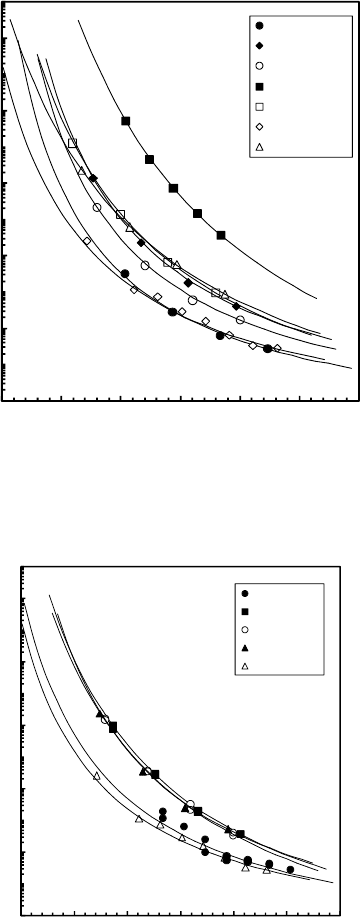
Lubricants for the Disk Drive Industry 529
1×10
4
1×10
2
1×10
0
1×10
−2
1×10
−4
1×10
−6
0 25 50 75 100 125 150
η/M
n
(Pa s/Da)
T−T
g
°
Z03
Zdiac
Zdeal
Ztetraol 2000
Ztx
Zdol4KL905
Zdol 2500
FIGURE 22.1 The ratio of viscosity to molecular weight as a function of distance from the glass transition
temperature for the PFPE Z series. (Adapted from Rudnick, L.R. (ed.), Synthetics, Mineral Oils, and Bio-Based
Lubricants Chemistry and Technology, Chapter 38, CRC Press, Taylor & Francis Group, Boca Raton, FL, 2006.)
η/M
n
(Pa s/Da)
Zdol4KL819
Zdol4KL492
Zdol4KL990
Zdol4KL598
Zdol4KL905
1×10
4
1×10
2
1×10
0
1×10
−2
1×10
−4
1×10
−6
0
25
50 75
100 125
150
T−T
g
o
FIGURE 22.2 The ratio of viscosity to molecular weight as a function of distance from the glass transi-
tion temperature for the PFPE Zdol4K series, showing the effect of O/C ratio. The smooth curves are from
the WLF equation. (Adapted from Rudnick, L.R. (ed.), Synthetics, Mineral Oils, and Bio-Based Lubricants
Chemistry and Technology, Chapter 38, CRC Press, Taylor & Francis Group, Boca Raton, FL, 2006.)
The segmental friction coef cient for the D and K series, shown in Figure 22.3, was within the
range of that observed for the Zdol4K series in Figure 22.2. The nonpolar Krytox and the Krytox
COOH were nearly the same as one another and were below the Demnum series. All of the Demnum
series were nearly the same as one another. The addition of one polar end group had little effect on
the segmental friction coef cient of D and K.
CRC_59645_Ch022.indd 529CRC_59645_Ch022.indd 529 3/20/2009 5:44:22 PM3/20/2009 5:44:22 PM
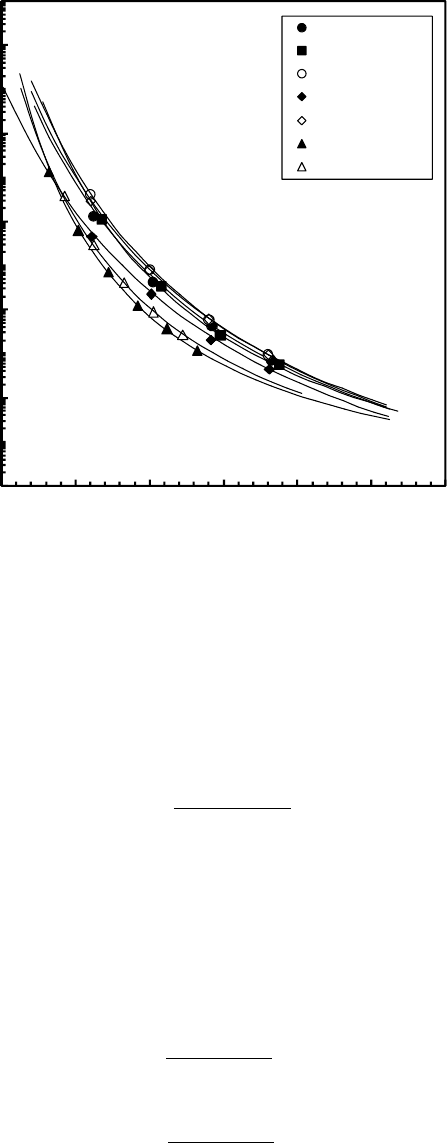
530 Lubricant Additives: Chemistry and Applications
The storage and shear moduli, G′ and G″, were measured and shifted along the temperature
axis to obtain the master curves. The WLF coef cients [29] were calculated from the shift factors
a
T
o
(T) by nonlinear regression analysis using the functional form
log a
CT T
CTT
T
o
o
o
()
()
()
⫽
⫺⫺
⫹⫺
1
2
(22.1)
where the reference temperature T
o
= T
g
and C
1
and C
2
are the WLF coef cients with respect
to T
g
. The WLF coef cients are listed in Table 22.5. Our range of coef cients 10.5 < C
1
< 23.5
and 23.5 < C
2
< 79 is consistent with that for nonpolar PFPEs Y and Z reported by Marchionni
et al. [18].
Up to three Maxwell elements were derived from the master curves by nonlinear regression
analysis from the linearly viscoelastic shear storage modulus, G′, and loss modulus, G″:
′
∑
G
Ga
a
iTi
Ti
i
⫽
⫹
()
()
o
o
2
2
1
(22.2)
′′
∑
G
Ga
a
iTi
Ti
i
⫽
⫹
o
o
1
2
()
(22.3)
where ω is the shear strain sinusoidal oscillation frequency.
Demnum S100
Demnum SA2000
Demnum SA2
Demnum DPA
Demnum SH
Krytox 143AD
Krytox COOH
1×10
4
1×10
2
1×10
0
1×10
−2
1×10
−4
1×10
−6
η/M
n
(Pa s/Da)
0
25
50
75 100
125
150
T−T
g
o
FIGURE 22.3 The ratio of viscosity to molecular weight as a function of distance from the glass transi-
tion temperature for the PFPE Demnum and Krytox series. The smooth curves are from the WLF equation.
(Adapted from Rudnick, L.R. (ed.), Synthetics, Mineral Oils, and Bio-Based Lubricants Chemistry and Tech-
nology, Chapter 38, CRC Press, Taylor & Francis Group, Boca Raton, FL, 2006.)
CRC_59645_Ch022.indd 530CRC_59645_Ch022.indd 530 3/20/2009 5:44:23 PM3/20/2009 5:44:23 PM

Lubricants for the Disk Drive Industry 531
The shear rigidities G
i
and corresponding relaxation times τ
i
are listed in Table 22.6 [1]. The WLF
coef cients, the shear rigidities, and the relaxation times provide the solid curves in Figures 22.4
through 22.6 [1]. The dynamic response for the Z series with different end groups is shown in
Figure 22.4. The polar end group increases the relaxation times. Two relaxation times are observed
in the Zdiac, Zdeal, and Zdol4KL905. Three relaxation times are observed in the Ztetraol and
Zdol4KLl819. At ambient temperature, the Z03 has nearly the shortest characteristic time, τ
1
, of
all the PFPEs even though it has the highest M
n
. Ztetraol has the longest τ
1
within the Z series.
The response of the Zdol with a range of O/C ratio is shown in Figure 22.5. The O/C ratio has a
signi cant effect on the dynamic response of the Zdol 4K series. The dynamic response of the
Demnum and Krytox is shown in Figure 22.6. The τ
1
for the Krytox is much longer than that for
the Demnum.
The linear viscoelastic properties zero shear viscosity η = G
1
τ
1
and the equilibrium recover-
able compliance J
0
e
= τ
1
/η may be calculated from the dynamic properties listed in Table 22.6. The
viscosity or relaxation time can be calculated at an arbitrary temperature T with the ratio of the shift
factors from the WLF equation. For example, τ
1
(T) or η(T) = η(T
g
)a
Tg
(T). The relaxation times for
the Z series of lubricants calculated at 50ºC is shown in Figure 22.7 [1].
22.2.1.2 Dielectric
The lubricant dielectric properties provide complementary information to the rheological data. The
concept is similar in that both energy storage and dissipation are characterized in response to a
sinusoidal application of an electric eld.
TABLE 22.6
The Coeffi cients of the Maxwell Elements from the Master Curves at Reference
Temperature T
g
η (−20°C) (Pa s)
Lubricant G
1
(kPa) τ
1
(s) G
2
(kPa) τ
2
(s) G
3
(kPa) τ
3
(s)
From
Creep
From
Dynamic
Z03 49.3 1.11 × 10
7
— — — — 0.2 0.2
Zdiac 28.4 5.17 × 10
10
5.6 3.09 × 10
9
— — 1.0 1.0
Zdeal 31.1 6.31 × 10
9
4.0 1.44 × 10
8
— — 0.4 0.4
Ztetraol 2000 36.6 4.02 × 10
13
8.9 3.86 × 10
12
5.5 3.16 × 10
11
83 70
Ztx 55.6 7.42 × 10
6
— — — — 2.0 1.6
Zdol4KL819 4.0 3.56 × 10
5
5.2 7.91 × 10
4
14.3 8.13 × 10
3
0.2 0.5
Zdol4KL492 43.4 1.51 × 10
7
— — — — 1.3 1.1
Zdol4KL990 49.7 5.77 × 10
6
— — — — 1.3 1.5
Zdol4KBL598 48.4 2.10 × 10
8
— — — — 2.3 1.4
Zdol4KL905 19.3 2.40 × 10
3
19.7 2.21 × 10
2
— — 0.3 0.2
Zdol 2500 51.9 5.03 × 10
4
— — — 2.2 2.0
Demnum S100 11.8 4.52 × 10
4
38.0 9.91 × 10
3
3.4 2.84 × 10
2
3.7 1.5
Demnum SA2000 54.0 4.09 × 10
5
— — — — 1.1 1.5
Demnum SA2 35.1 5.49 × 10
4
10.4 6.43 × 10
3
— — 2.8 2.1
Demnum DPA 42.0 1.87 × 10
8
3.38 1.22 × 10
7
— — 3.6 2.5
Demnum SH 47.5 2.28 × 10
4
6.8 1.60 × 10
3
— — 2.9 2.8
Krytox 143 AD 55.3 1.35 × 10
5
3.1 4.30 × 10
3
1.0 1.16 × 10
2
81 69
Krytox COOH 44.9 3.08 × 10
4
4.7 1.21 × 10
3
2.3 7.17 × 10
1
220 200
Note: The steady shear viscosity measured in creep, and the zero shear viscosity calculated from the dynamic data at −20°C.
Source: Adapted from Rudnick, L.R. (ed.), Synthetics, Mineral Oils, and Bio-Based Lubricants Chemistry and Technology,
Chapter 38, CRC Press, Taylor & Francis Group, Boca Raton, FL, 2006.
CRC_59645_Ch022.indd 531CRC_59645_Ch022.indd 531 3/20/2009 5:44:23 PM3/20/2009 5:44:23 PM
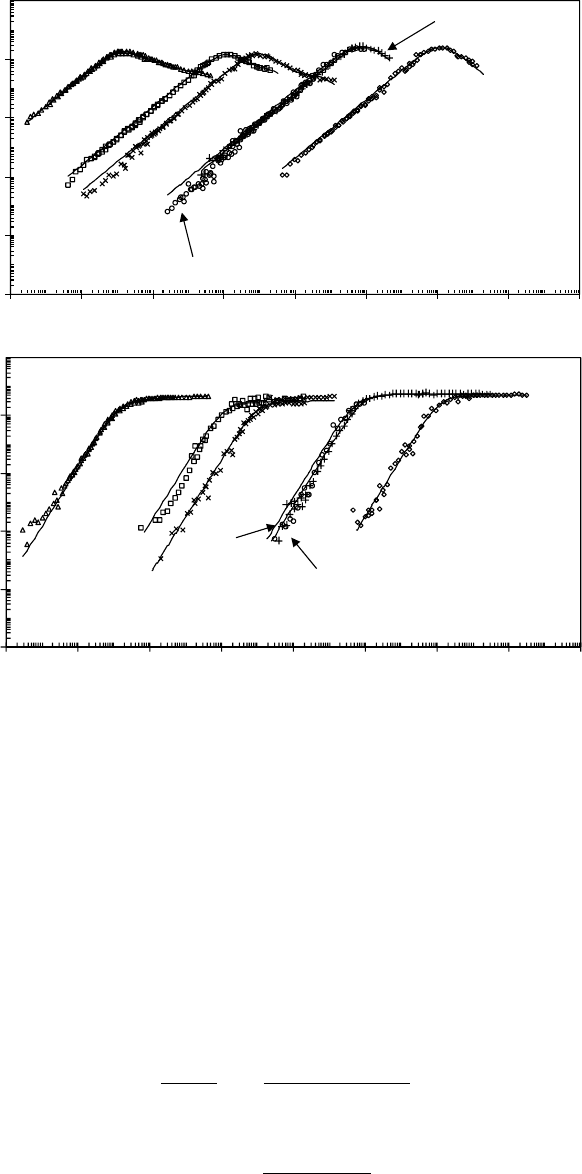
532 Lubricant Additives: Chemistry and Applications
The permittivity and loss factor of the different lubricant samples were measured using a TA
Instruments Dielectric Analyzer (DEA) model 2970 with a single-surface ceramic sensor. Measure-
ments were taken at an applied voltage of 1 V. The frequency sweep ranged from 0.1 to 10,000 Hz.
Measurements were done at temperatures ranging from −100 to 100°C. The data at the various
temperatures were shifted relative to reference temperature T
0
= 50°C to provide the dielectric
master curves for several magnetic recording disk lubricants, shown in Figure 22.8 [1].
The dielectric properties are derived from the master curves with a discrete relaxation time
(Debye) model [31] for the dielectric loss factor, ε″, and the dielectric permittivity, ε′:
′′
()
∑
⫽⫹
⫺
⫹
0
2
0
0
0
1
a
a
a
T
T
T
i
()
s,i i
i
⬁
(22.4)
′
()
∑
⫽⫹
⫺
⫹
⬁
⬁s,i
i
1
0
2
a
T
i
(22.5)
1×10
−16
1×10
4
1×10
2
1×10
0
1×10
−2
1×10
−4
1×10
4
1×10
2
1×10
0
1×10
−2
1×10
−4
1×10
−16
1×10
−14
1×10
−12
1×10
−10
1×10
−8
1×10
−6
1×10
−4
1×10
−2
1×10
0
1×10
−14
1×10
−12
1×10
−10
1×10
−8
1×10
−6
1×10
−4
1×10
−2
1×10
0
G′′ (Pa)G′ (Pa)
ωa
T
g
(rad/s)
ωa
T
g
(rad/s)
Z03
Ztetraol
Zdol 2500
(a)
Zdiac
Zdeal
Ztx
Z03
Ztetraol
Zdiac
Zdol 2500
(b)
Zdeal
Ztx
FIGURE 22.4 Shear loss (a) and storage (b) modulus master curves for the Z series. The smooth curves are
from the discrete relaxation time series t to the frequency–temperature shifted data. Reference temperature
is T
g
. (Adapted from Rudnick, L.R. (ed.), Synthetics, Mineral Oils, and Bio-Based Lubricants Chemistry and
Technology, Chapter 38, CRC Press, Taylor & Francis Group, Boca Raton, FL, 2006.)
CRC_59645_Ch022.indd 532CRC_59645_Ch022.indd 532 3/20/2009 5:44:24 PM3/20/2009 5:44:24 PM
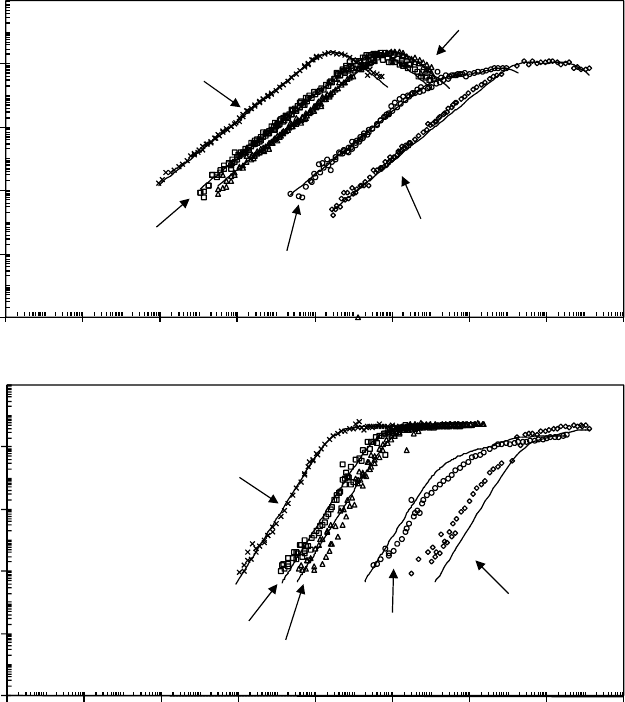
Lubricants for the Disk Drive Industry 533
where
ω = sinusoidal oscillation frequency of the applied voltage
τ
i
= dielectric relaxation time
ε
0
= absolute permittivity of free space (8.85 × 10
−12
F/m)
The parameters in the discrete relaxation time series are determined by a regression t to the dielectric
master curves. There are multiple dielectric relaxation times for Zdol and Ztetraol. Four relaxation
times were employed to t the data in Figure 22.8. These provide estimates for the conductivity, σ, the
dc relative permittivity, ε′(0) = ∑
i
ε
s,i
, and the limiting high-frequency permittivity, ε
∞
. Note that the
capacitive energy storage is proportional to the dc relative permittivity, and the refractive index n
is related to the high-frequency relative permittivity by the Maxwell relation n ≈
√
___
ε
∞
. For PFPEs,
n ≈ 1.3 [28], which gives ε
∞
≈ 1.7. The dielectric properties and the four relaxation times and static
relaxation amplitudes are listed in Table 22.7 [1].
Zdol4KL990
(a)
(b)
Zdol4KL492
Zdol4KL819
Zdol4KL905
Zdol4KBL598
Zdol4KL990
Zdol4KL492
Zdol4KL819
Zdol4KL905
Zdol4KBL598
1×10
−16
1×10
4
1×10
2
1×10
0
1×10
−2
1×10
−4
1×10
4
1×10
2
1×10
0
1×10
−2
1×10
−4
1×10
−14
1×10
−12
1×10
−10
1×10
−8
1×10
−6
1×10
−4
1×10
−2
1×10
0
G′′ (Pa)G′ (Pa)
ωa
T
g
(rad/s)
1×10
−16
1×10
−14
1×10
−12
1×10
−10
1×10
−8
1×10
−6
1×10
−4
1×10
−2
1×10
0
ωa
T
g
(rad/s)
FIGURE 22.5 Shear loss (a) and storage (b) modulus master curves for the Zdol4K series. The smooth
curves are from the discrete relaxation time series t to the frequency–temperature shifted data. Reference
temperature is T
g
. (Adapted from Rudnick, L.R. (ed.), Synthetics, Mineral Oils, and Bio-Based Lubricants
Chemistry and Technology, Chapter 38, CRC Press, Taylor & Francis Group, Boca Raton, FL, 2006.)
CRC_59645_Ch022.indd 533CRC_59645_Ch022.indd 533 3/20/2009 5:44:24 PM3/20/2009 5:44:24 PM
